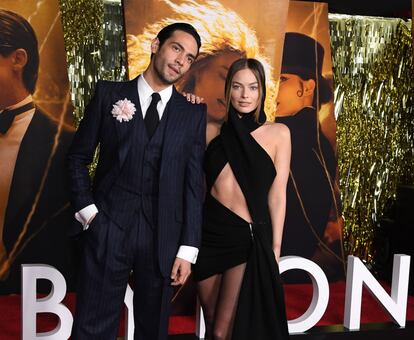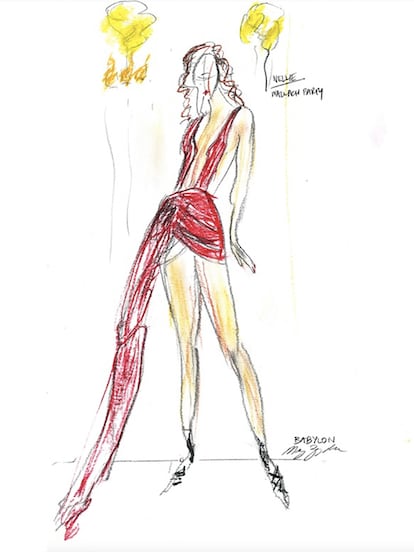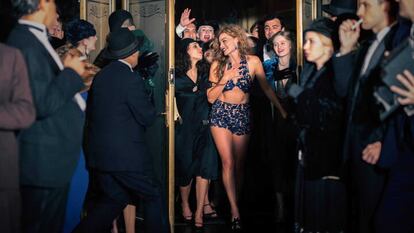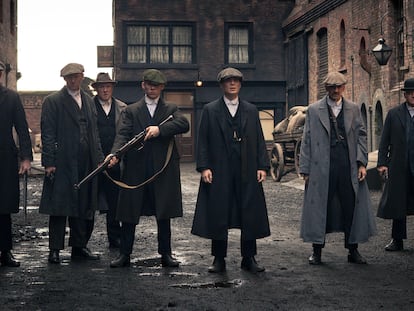‘Babylon’: How Margot Robbie’s costumes put a new twist on 1920s fashion
Designer Mary Zophres said she was specifically told to avoid the flapper style the era is known for

Babylon is about the world of cinema in the late 1920s and the excesses of the Hollywood movie machine. It is a story of boundless ambition that traces the rise and fall of its protagonists, played by Margot Robbie and Diego Calva, as the silent film era comes to an end due to the advent of sound.
The 1920s were characterized by hope and optimism, as society embraced new ways of being. In terms of fashion, the decade was defined by the flapper look, with women wearing low cut, below-the-knee dresses and dropped belts that accentuated slim waistlines. Common accessories of the time included necklaces, long gloves, feathers, headbands and cloche hats – a look that spoke of glamour and frivolity.
But while Babylon is set in the 1920s, it does not follow the traditional style of the time. The movie’s director Damien Chazelle specifically told costume designer Mary Zophres (who worked with him on La La Land), to try something different. “He really wanted to challenge [me and production designer Florencia Martin] to try to make it not look like another movie about the 1920s,” said Zophres in an interview with BoxOfficePro. For the costume designer, that meant starting from scratch.

Zophres and her team created 7,000 costumes for the epic about Hollywood’s lawless years. They began by researching photos from the period, as well as music and paintings from that time. Zophres contacted museums, design institutes and costume houses in the hopes of finding a garment that wasn’t a 1920s fashion cliché. But she had no luck.
Despite the initial setbacks, she didn’t give up. In the BoxOfficePro interview, she explained: “First off, all the old clothes don’t exist anymore, because they’re 100 years old. And if you do find something original, it’s going to disintegrate. But it was very helpful in seeing how things were constructed and what fabrics they were using. And stitching. And tailoring.”
When Robbie’s character Nellie LaRoy appears in the film for the first time, she is wearing a skimpy red dress. Zophres told Variety magazine that it was the perfect opportunity to use red. “It’s power and seduction all in one. There’s a reason the red dress has this reputation that precedes itself,” said the designer, who made sure that no other character was wearing the color in the scene.

The outfit is also based on Nellie’s backstory as a dancer from New York who’s pursuing her dreams of becoming an actress in Hollywood. “To me, she cobbled that outfit together,” said Zophres, who also had the idea that she would wear tap shorts. It was all designed so that Robbie could move around and dance as freely as possible.
The costumes also reflect the dramatic changes the film industry was undergoing at that time: not only with the advent of sound, but also the introduction of the Motion Picture Production Code, a set of industry guidelines for the self-censorship of content. “Art was changing drastically, and I liken that to what was happening in women’s fashion,” said Zophres.

The costumes in Bablyon reflect the movie’s key themes and bring to life Robbie’s character, who is trying to carve out a niche for herself in a changing Hollywood.
Babylon has been nominated for three Oscars, including Best Costumes – an important recognition of Zophres’ work. She says that Babylon has been one of the most challenging but creative projects she has ever undertaken.
Sign up for our weekly newsletter to get more English-language news coverage from EL PAÍS USA Edition
Tu suscripción se está usando en otro dispositivo
¿Quieres añadir otro usuario a tu suscripción?
Si continúas leyendo en este dispositivo, no se podrá leer en el otro.
FlechaTu suscripción se está usando en otro dispositivo y solo puedes acceder a EL PAÍS desde un dispositivo a la vez.
Si quieres compartir tu cuenta, cambia tu suscripción a la modalidad Premium, así podrás añadir otro usuario. Cada uno accederá con su propia cuenta de email, lo que os permitirá personalizar vuestra experiencia en EL PAÍS.
¿Tienes una suscripción de empresa? Accede aquí para contratar más cuentas.
En el caso de no saber quién está usando tu cuenta, te recomendamos cambiar tu contraseña aquí.
Si decides continuar compartiendo tu cuenta, este mensaje se mostrará en tu dispositivo y en el de la otra persona que está usando tu cuenta de forma indefinida, afectando a tu experiencia de lectura. Puedes consultar aquí los términos y condiciones de la suscripción digital.
More information
Archived In
Últimas noticias
Most viewed
- Sinaloa Cartel war is taking its toll on Los Chapitos
- Oona Chaplin: ‘I told James Cameron that I was living in a treehouse and starting a permaculture project with a friend’
- Reinhard Genzel, Nobel laureate in physics: ‘One-minute videos will never give you the truth’
- Why the price of coffee has skyrocketed: from Brazilian plantations to specialty coffee houses
- Silver prices are going crazy: This is what’s fueling the rally










































